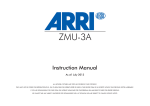Download Shift & Tilt Bellows System
Transcript
SHIFT & TILT BELLOWS SYSTEM Instruction Manual as of: May 1995 ALL ARTWORK, PICTURES AND TEXTS ARE COVERED BY OUR COPYRIGHT. THEY MUST NOT BE COPIED FOR REPRODUCTION (E.G. ON CD-ROM DISKS OR INTERNET-SITES) OR USED IN THEIR ENTIRE FORM OR IN EXCERPTS WITHOUT OUR PREVIOUS WRITTEN AGREEMENT. IF YOU ARE DOWNLOADING PDF-FILES FROM OUR INTERNET HOMEPAGE FOR YOUR PERSONAL USE, MAKE SURE TO CHECK FOR UPDATED VERSIONS. WE CANNOT TAKE ANY LIABILITY WHATSOEVER FOR DOWNLOADED FILES, AS TECHNICAL DATA ARE SUBJECT TO CHANGE WITHOUT NOTICE. lock for lens rotation mark for lens rotation lens rotation scale for tilting lock for tilting scale for shifting index pin shifting tilting support rod clamp scale for swinging lock for focus swinging support rod clamp focus-knob adapter for 15 mm support rods support rod clamp note: magnification scales refers to projection aperture 1:1.85 (width = 21mm/ 0.825") 1. Place scale in object plane 2. Align arrow with left edge of the frame 3. Magnification ratio and the corresponding exposure increase can be read off at the right edge of the frame exposure increase in stops 4 3 21/2 2 1 2/3 1 1/3 3/ 4 1 2 1 /3 1 /2 /3 align with left edge of the frame 4:1 2:1 1:1 1:2 1:3 1:4 1:5 magnification ratio 1:6 1:7 1:8 Shift & Tilt Bellows System 1. Safety Specifications Warnings Danger of injury or equipment damage possible! General Safety Specifications Due to the flexible bellows design, adjustments are possible which surpass the technical possibilities of the attached lens. Optically, extreme settings may cause vignetting. Mechanically, some lenses may collide with the bellows unit due to their design. All settings must therefore be executed with the necessary caution. • In order to ensure optimal performance, it is essential that you acquaint yourself with this instruction manual. • Assembly and initial operation should be carried out only by persons who are familiar with the equipment! • Repairs should be carried out only by authorized service centers! • Only use original ARRI replacement parts and accessories! 1 Shift & Tilt Bellows System Important Notes • Avoid operational errors! • Following shift and tilt adjustments check the viewfinder at the chosen T-stop to avoid unwanted vignetting! In case of doubt a film test should be shot. • Use lens caps to avoid damage! • Clean optical surfaces only with a lens brush or a clean lens cloth! In case of solid dirt moisten a lens cloth with pure alcohol. • Do not use solvents for cleaning! • Do not remove any screws which are secured with paint! Product Specifications In case of inquiries or when ordering parts, please advise product designation and serial number. Explanation of the Symbols in the Instruction Manual ➪ photo indicates objects which are shown in the photograph on the fold-out page. 2 Shift & Tilt Bellows System 2. Contents 1. Safety Specifications ...................... 1 Warnings ............................................... 1 General Safety Specifications ................... 1 Important Notes ...................................... 2 Product Specifications .............................. 2 Explanation of the Symbols....................... 2 2. Contents ............................................. 3 3. General Description ........................ 4 4. Setting Up ......................................... 6 4.1. Attaching the Support Rod Adapter .... 6 4.2. Mounting the Bellows Unit ................. 7 4.3. Attaching the Lens ............................ 8 4.4. Setting the Working Position of the Shift & Tilt System ........................... 9 5. Operation ........................................ 11 5.1. Focusing ....................................... 11 5.2. Setting the Working Aperture ........... 12 5.3. Shift .............................................. 13 Working Examples (Shift) ....................... 14 5.4. Tilt ................................................ 17 Scheimpflug Condition ........................... 18 Working Examples (Tilt) .......................... 19 6. Technical Data ................................ 20 7. Order Numbers .............................. 23 3 Shift & Tilt Bellows System 3. General Description The ARRI Shift & Tilt bellows system comprises a bellows unit as well as a set of lenses that cover a significantly larger image area than is required to cover the conventional format area on film. The lenses are attached to the bellows unit via a bayonet mount. The bellows unit is attached to the camera with the standard PL-Mount. The flexible bellows allows the attached lens to be • shifted parallel to the film plane • rotated around its optical axis and • tilted. This opens up creative possibilities that go far beyond those given by the focus and iris adjustments of conventional lenses. Some applications are: Shift • Eliminating perspective distortion in architectural photography; • Avoiding unwanted reflections; • Excluding unwanted objects in the foreground; • Changing framing without moving the camera; Tilt • Free adjustment of a focus plane, i. e. focusing on a plane that is not parallel to the film plane; • Isolating a particular subject area with a specifically chosen focus plane, as well as combinations of shift and tilt. 4 Shift & Tilt Bellows System Because of the bellows extension, the system can also be used for close-up and macro cinematography. The bellows unit is particularly robust and precise. Corresponding operating elements are color-coded. All adjustments are carried out via transmissions. An index scale facilitates the exact duplication of chosen settings. The focusing knob features a white marking disk on which focus positions can be individually marked, as well as a connection for mechanical remote controls. The lenses were specifically designed for this application. The bayonet mount facilitates quick lens changes. The double aperture scales, located opposite each other, are calibrated in T-stops and are easily readable from the side. Uniform design, a consistent front diameter of 87 mm and the geared iris ring offer further user-comfort. The system can be used with both 35 and 16 mm cameras. 5 Shift & Tilt Bellows System 4. Setting Up 4.1. Attaching the Support Rod Adapter The bellows unit can be used with 19 mm as well as with 15 mm support rods. An appropriate adapter ➪ photo is available for each support rod diameter. • Undo the four screws located at the bottom of the currently mounted adapter. • Replace with desired adapter. • Fasten the adapter with the four screws located at the bottom. 6 Shift & Tilt Bellows System 4.2. Mounting the Bellows Unit • Ensure that the support rod clamps on the adapter are loosened. • Turn the focusing knob ➪ photo clockwise to its end stop. • Ensure that all shift and tilt adjustments ➪ photo are in their neutral (centered) positions. • Slide the bellows unit onto the support rods. • Turn the bayonet ring of the camera’s PL-receptacle counterclockwise as far as it will go and remove the protective cap. Never put your fingers into the lens mount receptacle. • Push the PL-mount of the bellows unit into the lens mount receptacle without catching it at the edges. One of the four slots on the flange must fit over the index pin. • Pull the bayonet ring on the camera clockwise to tighten. Do not over-tighten. The final position of the bellows unit on the support rods is set after attaching the desired lens. 7 Shift & Tilt Bellows System 4.3. Attaching the Lens • Pull tight the clamp for lens rotation ➪ photo. • Turn the bayonet ring of the unit’s lens mount receptacle counterclockwise as far as it will go. • Push the lens into the lens mount receptacle without catching it at the edges. One of the four slots on the lens mount must fit over the index pin ➪ photo. • Press the lens flat onto the lens mount receptacle and pull the bayonet ring clockwise to tighten. Do not over-tighten. 8 Shift & Tilt Bellows System 4.4. Setting the Working Position of the Shift & Tilt System • Open the iris of the lens all the way. • Ensure that the focusing knob ➪ photo is turned clockwise to its end stop. • Slide the entire bellows unit on the support rods until the most distant relevant element of the image is in focus. Check focus with the camera’s viewfinder. • Subsequently, slide the bellows unit somewhat closer to the camera body and clamp into position on the support rods. 9 Shift & Tilt Bellows System S D object plane film plane Maximum Magnification Lens max. reproduction-ratio Distance lens to Distance filmplane to approx. object in mm/inches (S) object in m/inches (D) T3.8/18mm 1:1.8 0/0 0.13/ 0'5" T2.8/20mm T4/24mm T2.8/28mm T2.8/35mm 1:1.5 1:1.6 1.1:1 1:1.1 0/0 0/0 5/ 1/5" 0.13/ 0'5" 0.18/ 0'7" 0.17/ 0'61/2" T2.8/45mm T3.5/60mm 1:1.25 1:1.8 10/ 2/5" 20/ 3/4" 100/ 4" 0.17/ 0'61/2" 0.20/ 0'8" 0.29/ 1' T1.9/80mm T2.8/90mm T2/110mm 1:2.4 1:2.5 1:3.2 180/ 7" 240/ 91/2" 400/ 153/4" 0.37/ 1'23/4" 0.42/ 1'41/2" T2.8/150mm 1:4.5 820/ 321/3" 10 0.58/ 1'11" 1.0/ 3'4" Shift & Tilt Bellows System 5. Operation 5.1. Focusing The focusing knob on the bellows unit ➪ photo is used for focusing. Because of the adjustable bellows, an extended close-focus range is available. The corresponding magnification ratios are listed in the table on page 10. Attention: Because of the extension of the bellows during close-focusing an appropriate exposure compensation is necessary. See under Section 5.2. Setting the Working Aperture A scale for determining the reproduction ratio and the exposure compensation is printed on the back fold-out page. • Always check focus in the camera’s viewfinder following shift or tilt adjustments 11 Shift & Tilt Bellows System 5.2. Setting the Working Aperture The Shift & Tilt System allows the full image circle of the lens to be utilized. Because of this however, there is a certain risk that the difference in illumination between the center and the edge of the image will become visible. According to the cos4 Θ− law, a difference in exposure of up to two stops can result. Attention: Check the viewfinder image for vignetting! In the close-focus range, a loss of light results from the bellows extension. The approximate values for exposure compensation are listed in the following table. See also the scale on the back pull-out page. Attention: Because of the extension of the bellows during close-focusing an appropriate exposure compensation is necessary. Exposure Compensation Reproduction Ratio Open Iris by approx. 6:1 51/2 Stops 4:1 41/2 Stops 2:1 3 Stops 1:1 2 Stops 1:1.5 11/2 Stops 1:2 11/4 Stops 1:2.5 1 Stop 3 1:3.5 /4 Stop 2 1:4.5 /3 Stop 1 1:6.5 /2 Stop 12 Shift & Tilt Bellows System 5.3. Shift The shifting of the lens parallel to the film plane can be used for several different purposes, among them: • Eliminating perspective distortion in architectural photography; • Excluding unwanted objects in the foreground; • Avoiding unwanted reflections; • Changing framing without moving the camera. Shifting of the lens can cause the composed image to be positioned at the very edge of the lens’s image circle, which in turn can lead to vignetting. Following shift and/or aperture adjustments always check the viewfinder image to avoid unwanted vignetting. Note also that even with a sufficiently large image circle, vignetting can also be caused by the matte-box. By rotating the lens, a shifting can be carried out in any desired direction. • Before rotating the lens, release the rotation lock ➪ photo on the bellows unit. 13 Shift & Tilt Bellows System Working Examples Changing framing without moving the camera 2: shi ftin g ing 1: image area image circle 14 olv rev Shift & Tilt Bellows System Correcting perspective side view result 15 Shift & Tilt Bellows System Excluding unwanted objects in the foreground Avoiding unwanted reflections 16 Shift & Tilt Bellows System 5.4. Tilt With lenses that are rigidly fixed to the camera body, the plane in the subject area that is in focus is parallel to the film plane. If the lens is tilted with the Shift & Tilt System, this focus plane is displaced correspondingly. The bellows unit can be adjusted in two axes (“tilt” and “swing”) simultaneously, thus allowing the focus plane to be angled in two directions (up/down, left/right). Because of this, the Shift & Tilt System enables • free adjustment of a focus plane, i. e. focusing on a plane that is not parallel to the film plane or • isolating a particular subject area with a specifically chosen focus plane. Tilting or swinging the lens can cause the composed image to be positioned at the very edge of the lens’s image circle, which in turn can lead to vignetting. Following tilt or swing and/or aperture adjustments always check the viewfinder image to avoid unwanted vignetting. Note also that even with a sufficiently large image circle, vignetting can also be caused by the matte-box. • Before tilting or swinging the lens, release the corresponding locks ➪ photo on the bellows unit. 17 Shift & Tilt Bellows System Scheimpflug Condition By tilting the lens it is possible to adjust a focus plane that is not parallel to the film plane. The Scheimpflug Condition establishes that a plane in the subject area will be in focus when • the film plane, • the lens plane and • the focus plane in the subject area all intersect in one line. This plane will then be completely in focus, even at maximum aperture. The depth of field of a lens depends on • the focal length of the lens, • the set working aperture and • the distance a which the lens is focused. When the lens is tilted or swung, the depth of field is displaced along with the focus plane. standard-situation without shift & tilt system depth of field standard lens lens plane object plane 18 film plane Shift & Tilt Bellows System Working Examples Setting a focus plane settings according to the Scheimpflug condition object plane lens plane film plane depth of field Isolating a particular subject area with selective focus By setting the lens plane against the Scheimpflug Condition, an extremely small depth of field can be achieved. This can be used for optically isolating individual objects. object plane depth of field lens plane film plane 19 Shift & Tilt Bellows System 6. Technical Data Bellows Unit Mount camera side: .......... PL-Mount Mount lens side: .............. Bayonet-type mount Support: ....................... Adapter for 19 and 15 mm support rods Shiftadjustment: .............. +/- 10 mm (3/8“) displacement (scale division = 1 mm) Rotation: ...................... 360 degrees Tiltadjustment: ................ horizontal +/- 10 degrees (scale division = 1 degree) vertical +/- 10 degrees (scale division = 2 degrees) Focusadjustment: ............. 30 mm (1 1/4“) Weight: ........................ approx. 1100 g (2 1/2 lb.) w/ adapter, w/o lens Options • PL-Adapter, e. g. for using the ARRIMACRO-lenses in the macro range. • Retro-Adapter, for using the lenses in the retrofocusposition for extreme magnification. 20 (1.7") 87 mm 2.8…22 (1.52") 95 mm 3.8…22 330 / 0.72 59 46 61 35 Front diameter T-Stop scale Weight [g/lb.] Lens angle [degrees] TV horizontal TV vertical 1.85:1 horizontal 1.85:1 vertical 47 27 46 35 480 / 1 (2.29") 87 mm 4…22 9 58.2 mm 24/T4 24 mm 1:3.5 11 41 23 40 30 400 / 0.88 (2.29") 87 mm 2.8…22 10 58.2 mm 28/T 2.8 28 mm 1:2.8 12 33 18 32 25 300 / 0.66 (2.29") 87 mm 2.8…32 7 58.2 mm 35/T 2.8 35 mm 1:2.8 7 Note: the values above refer to standard 35mm format, 1.85:1 projected image and TV transmitted image 55 32 54 42 350 / 0.77 9 43.2 mm 10 38.6 mm No. of lens groups Image circle diameter 20/T 2.8 20 mm 1:2.8 11 18/T 3.8 18 mm 1:3.5 11 Focal length Max. aperture No. of lens elements 26 14 25 19 500 / 1.1 (2.29") 87 mm 2.8…22 9 58.2 mm 45/T2.8 45 mm 1:2.8 10 Shift & Tilt Bellows System 21 Shift & Tilt Bellows System 1,85:1 horizontal 1,85:1 vertical Front diameter T-Stop scale Weight [g / lb.] Lens angle [degrees] TV horizontal TV vertical No. of groups Image circle diameter Max. aperture No. of lens elements Focal length 20 11 19 14 (2.29") 87 mm 3.5…22 590 / 1.3 7 58.2 mm 1:3,5 7 60/T 3.5 60 mm 15 8 14 11 (2.29") 87 mm 1.9…22 510 / 1.12 6 58.2 mm 1:1,9 7 80/T 1.9 80 mm 13 7 13 10 (2.29") 87 mm 2.8…22 440 / 0.9 5 58.2 mm 1:2,8 6 90/T2.8 90 mm 11 6 10 8 (2.29") 87 mm 2…16 780 / 1.75 6 58.2 mm 1:2 7 110/T2 110 mm 8 4 8 6 (2.29") 87 mm 2.8…22 680 / 1.5 4 58.2 mm 1:2,8 5 150/T2.8 150 mm Note: the values above refer to standard 35mm format, 1.85:1 projected image and TV transmitted image 22 Shift & Tilt Bellows System 7. Order Numbers Shift & Tilt System .......................................... K0.52001.0 Bellows-Set comprising Bellows unit .................................................. K2.52009.0 Adapter 19 mm ............................................. K2.52008.0 Adapter 15 mm ............................................. K2.52004.0 Lens 24 mm/T4 ............................................. K2.52010.0 Lens 45 mm/T2.8 .......................................... K2.52011.0 Lens 90 mm/T2.8 .......................................... K2.52012.0 Lens 110 mm/T2 ........................................... K2.52013.0 optional Lens 18 mm/T3.8 .......................................... K2.52031.0 Lens 20 mm/T2.8 .......................................... K2.52018.0 Lens 28 mm/T2.8 .......................................... K2.52033.0 Lens 35 mm/T2.8 .......................................... K2.52032.0 Lens 60 mm/T3.5 .......................................... K2.52022.0 Lens 80 mm/T1.9 .......................................... K2.52017.0 Lens 150 mm/T2.8 ........................................ K2.52019.0 PL-Adapter .................................................... K2.52020.0 Retro-Adapter ................................................ K2.52021.0 Flexible Shaft (for Shift, Tilt, Rotation) ............... K2.34890.0 Focus lever .................................................... K2.32730.0 Flexible Shaft (for Focus) ................................. K2.32731.0 Flexible Shaft (for Focus), short ........................ K2.34100.0 23 ARRI Service ARRI SERVICE Germany ................. Arnold & Richter Cine Technik Türkenstraße 89 D-80799 München phone: (089) 3809-0 fax: (089) 3809-1244 fax service: (089) 3809-1793 E-mail service: [email protected] USA .......................... ARRI USA 617, Route 303 Blauvelt, New York 10913 phone: (914) 353 14 00 fax: (914) 425 12 50 E-mail: [email protected] ARRI USA 600 North Victory Blvd. Burbank, California 91502 phone: (818) 841 70 70 fax: (818) 848 40 28 E-mail: [email protected] GB ............................ ARRI (GB) Ltd. The Movie House 1-3 Airlinks, Spitfire Way phone: (0208) 848 88 81 fax: (0208) 561 13 12 E-mail: [email protected] ARRI Service Italy .......................... ARRI ITALIA S.R.L. Viale Edison 318 20099 Sesto S. Giovanni (Milano) Tel.: (02) 26 22 71 75 Fax: (02) 242 16 92 E-mail: [email protected] ARRI ITALIA S.R.L. Via Placanica, 97 00040 Morena (Roma) phone: (06) 79 89 02 02 fax: (06) 79 89 02 39 Canada .................... ARRI Canada Ltd. 415 Horner Avenue, Unit 11 Etobicoke, Ontario Canada M8W 4W3 phone: (416) 255 33 35 fax: (416) 255 33 99 E-mail: [email protected] © ARRI/KVW Specifications subject to change without notice Printed in Germany Ident-No. for Manual: K5.43422.0 available languages German English ARNOLD & RICHTER CINE TECHNIK TÜRKENSTR. 89 • D-80799 MÜNCHEN • TEL. (089) 3809-0 FAX (089) 3809 - 1244 • http://www.arri.de





























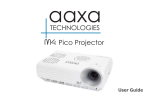
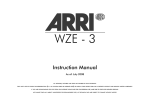

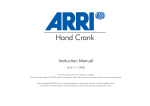
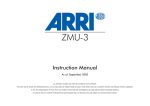
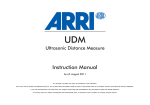

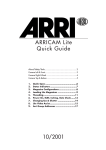
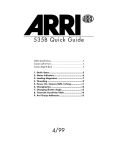
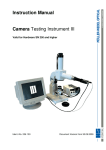
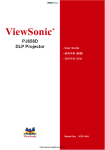
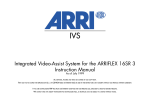
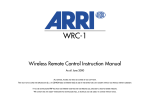
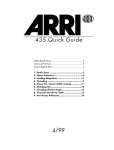
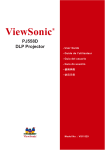
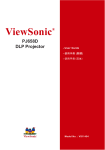
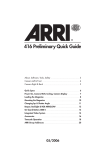

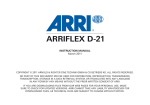
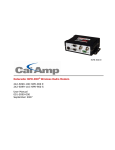
![Overview DR120 Service manual [v00]](http://vs1.manualzilla.com/store/data/006012884_1-f54ceab96779dba42a616edbeea41727-150x150.png)
